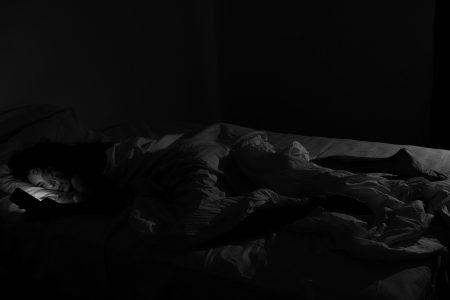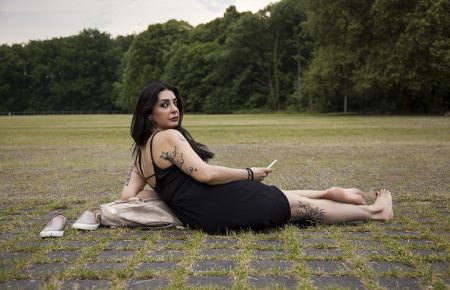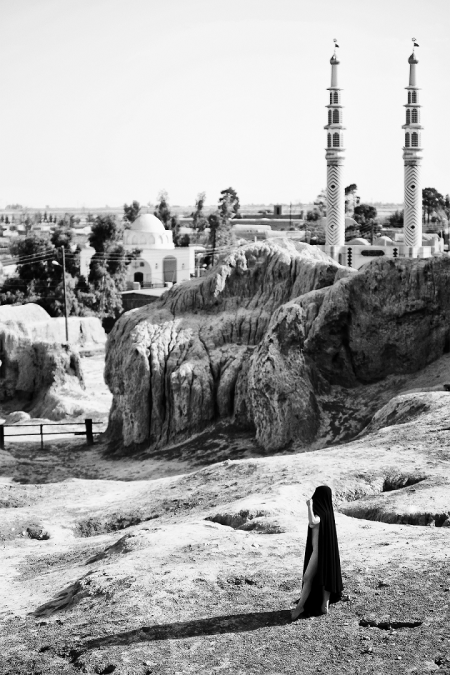Forty-two photographs and videos present a panoptic view of Persian youth culture in “Focus Iran 3: Contemporary Photography and Video,” the third Iranian photography biennial at Craft Contemporary in Los Angeles. Sponsored primarily by Farhang Foundation, a local nonprofit organization dedicated to promoting Iranian art, this sweeping juried exhibition suggests that despite our respective governments’ political dissension, the fundamental outlooks of individuals in Iran and the U.S. have more in common than many deem.
“Focus Iran 3” bridges the Iran-U.S. chasm in myriad ways. Some artists hail from Iran, while others are Iranian diaspora born in the U.S. and other countries. Diverse images by professionals, amateurs, documentary photographers, and fine artists are interlaced by a tenor of progressiveness. Given the youth culture theme, it’s little surprise that much of the work should challenge Iran’s cultural and governmental strictures. There is grim irony in the fact that many pieces would never be allowed on gallery walls inside Iran, yet because of our government’s current travel ban, none of the Iran-based artists were able to attend their opening. Displayed here in the U.S., their work acquires additional impact, counteracting Western misconceptions and stereotypes of Muslim cultures.
Throughout the show, didactic wall labels provide context, quotes by artists, and insight into aspects of Iranian life, conveying purport akin to an absorbing photo-essay. Enhancing the documentary feel, portrayals of people attending parks or museums, playing sports, smoking, and surfing attest to similarities between American and Iranian youths’ leisure while acknowledging peculiarities of Persian culture. One particularly memorable example, Memento (2009), by Farzad Ariannejad, depicts the back of a girl’s patterned headscarf blending into scribbled doodles on a chalkboard that students use to communicate with one another in a Shiraz park. The timeless frantic desire to express oneself while also making sense of others’ thoughts is poetically captured in this black-and-white image.
Much of the art transcends cultural specificity. Tehran-based artist Mona Morsi Abolmajid’s Sleeping Beauty (2018) hauntingly shows a prostrate woman’s face illuminated in bed by her phone like a creepy beacon in the dark. Her tired pose suggests that she should be sleeping, but is too enthralled by her gadget to actually rest. With sardonic humor, Mahsa Alikhani’s Tristes Persiques (2017) portrays a young Persian refugee in the Netherlands, her tattoos showing and cigarette in hand, reclining á la Ingres’ Odalisque.
The show’s strongest sub-theme is aimed at Iranian restrictions on freedom, particularly individuals’ lack of rights to self-expression. Many of the artists address issues relating to gender and gay identity, including three prizewinners selected by the jury. Awarded first place, The Brotherhood (2018) by Hushidar Mortezaie and Jiyan Zandi shows two colorfully dressed men wearing headdresses of roses, defying traditional masculinity in fashion and pose. Censored from a show in Iran, third-place winner Milad Karamooz’s The Kiss (2016) is a homoerotic bondage scene tendering cutting commentary on draconian restrictions of speech and homosexuality. In second place, Labkhand Olfatmanesh and Gazelle Samizay’s dreamlike video titled Bepar (2018) presents the game of hopscotch as an eerie metaphor for traumas and struggles girls face from childhood to adulthood.
Women’s resistance against oppression figures vibrantly in various artists’ work. Samira Roostaie’s practice of photographing herself nude in public places seems all the more daring in light of the fact that Iranian women are forced to enshroud their heads in hijabs; in a stunning photo titled The Veil and Minarets (2016), she poses before a venerable imposing mosque and dauntlessly peels back her burqa to expose a stretch of bare leg and torso—while derisively keeping her head veiled. Inspired by an ancient Persian fairytale, Mozhgan Erfani’s powerful portrait, Chel Giss (2016), features a Medusa-esque sorceress whose black mane rises wildly as a gnarled tree in rebellion against repressive customs. In Anahid Ghorbani’s hypnotic video, The Color Is Black (2017), a doubled woman traverses a lonely desert—then abruptly vanishes.
Defying those who would have them disappear, the multitudinous artists in this show insist upon being seen. Their work is so engrossing that one doesn’t want to look away.
–Annabel Osberg
“Focus Iran 3: Contemporary Photography and Video” is on view through May 12 at Craft Contemporary, 5814 Wilshire Blvd., Los Angeles, CA 90036, cafam.org. Later, it will travel to Viewpoint Gallery at UC Irvine, Oct. 5-Nov. 6, 2019.













April 1st, 2019at 4:54 pm(#)
With all the trials and tribulations in the world over so many different views, repressions, rules, regulations, and tradition it is inspiring to see that the world of art and artistic expression is still in the forefront of making change. Really enjoyed the photographs and the story content is exceptional. May each of us “artist” find the joy and sacrifices in the liberation of art around the world.